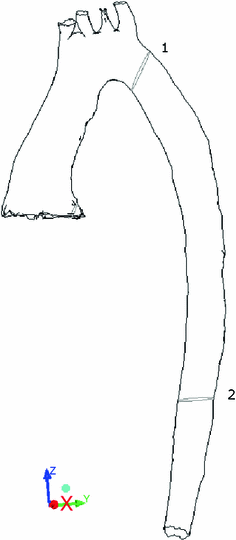Fig. 1
Circulation in normal subjects: the aorta is connected to the left ventricle, and is subjected to a large curvature in the ascending part. Patients who are eligible for the Mustard procedure have instead the aorta congenitally connected to the right ventricle (figure source: http://upload.wikimedia.org/wikipedia/commons/thumb/e/e5/Diagram_of_the_human_heart_%28cropped%29.svg/600px-Diagram_of_the_human_heart_%28cropped%29.svg.png)
The present study is meant to characterize the aortic hemodynamics in patients operated on with a Mustard procedure, in order to highlight whether the native connection of the aorta to the right ventricle can cause particular concerns, with respect to the physiological case.
2 Materials and Methods
MRI images of a patient operated on with Mustard procedure at the Bambino Gesù Pediatric Hospital, Rome, were processed with Mimics software (Materialise, Belgium), allowing the construction of a 3D model of the aorta, from the aortic root downstream to the abdominal aorta, including the supra-aortic arteries. The model was built by means of suitable (upper and lower) thresholds for intensity of the image.
The 3D model was subsequently imported into 3-matic software (Materialise, Belgium), in order to prune the parts not belonging to the aortic circulation. 3-matic offers design modification, design simplification, 3D texturing, remeshing, forward engineering, at the level of STereoLithography (STL) representation. STL is a file format developed by a stereo-lithography CAD software (3D Systems), but also supported by many other software packages. STL files describe only the surface geometry of a three dimensional object without any representation of color, texture or other common CAD model attributes. Since an STL file describes a raw unstructured triangulated surface, by means of the unit normal and vertices of the triangles, it gives a rather low-level model representation, which requires powerful software tools to be effectively further processed.
In particular, the possibility to design or repair missing or badly rendered components after thresholding of MRI images was very useful to build a realistic 3D model of the aortic district.
A volume mesh of about 2.75 millions tetrahedral was then created and imported in Ansys Fluent 12.1, a flexible general-purpose computational fluid dynamics software package used to model flow, turbulence, heat transfer, and other physical phenomena [1, 6].
Suitable boundary conditions were set at the input and outputs of the model. The flow (at the inlet section) and pressure (at the outflow sections, i.e., the cerebral arteries and the descending aorta) values were imposed according to the typical values in the subjects at the age of the candidate for the Mustard procedure.
The flow motion was described by the principle of momentum conservation, expressed by the Navier-Stokes equations:

where

is the stress tensor, and by the continuity equation, representing the principle of mass conservation:

Steady, laminar flow was assumed in the calculation. The blood was modeled as a Newtonian fluid, with 1.06 g/cc density and 3.5 cP dynamic viscosity.

(1)

(2)

(3)
We used the PISO scheme as solution method. The Pressure-Implicit with Splitting of Operators (PISO) pressure-velocity coupling scheme is a non-iterative method for solving the implicity discretised, time-dependent, fluid flow equations [4]. This technique allows to decouple operations on pressure from those on velocity. At each time-step, the procedure yields solutions which approximate the exact solution of the difference equations.
The PISO scheme is especially recommended for transient calculations, but it was also demonstrated that it is stable for fairly large time steps, which renders it useful for steady-state calculations as well [3]. Its usefulness is even more appreciable in case of steady-state simulations with distorted meshes. Actually, the unstructured tetrahedral mesh provided by the 3D reconstruction of the aortic model from MRI images was somewhat distorted, hence the PISO scheme allowed an improvement over faster but less accurate algorithms (e.g., SIMPLE).
As for pressure interpolation, the PREssure STaggering Option (PRESTO!) Scheme was used, as recommended for flows in strongly curved domains. The PRESTO! scheme uses the discrete continuity balance for a “staggered” control volume about the face to compute the “staggered” pressure (face pressure).
A custom software was written in the Matlab environment, in order to process the velocity and pressure data yielded by the CFD analysis for each section, and saved by the user in an ASCII file. The software enables to do a suitable transformation of the common coordinate system, in order to decompose the velocity vectors in two components, parallel and perpendicular to the given section. This feature enabled, in particular, an easy calculation of secondary flows.
Similarly to previous studies [7], we chose to evaluate the results in two sections, immediately downstream of the left subclavean artery (LSA) and in a section positioned in the descending aorta, at 14 cm below the center of the latter. These two sections will be denoted henceforth as Sects. 1 and 2, respectively.
Figure 2 shows the outline of the mesh for CFD simulation, with the two sections referred to above.




